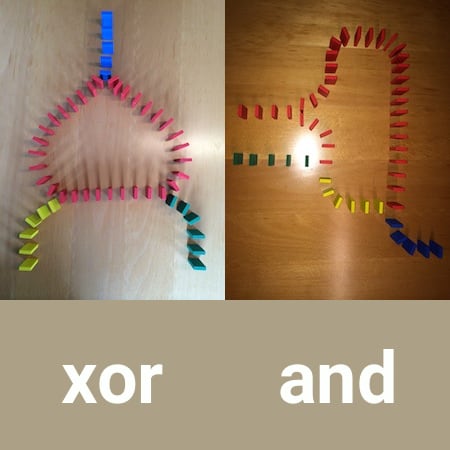
any / any
Analogy
Collected by Matthias Hauswirth — Own practice, based on Matt Parker's 'domino computer'
See inside logic gates/operations. Construct/invent them from atomic components, and observe/analyze their full workings.
| PL | NM |
|---|---|
| Boolean value | domino piece (standing, or fallen) |
| or operation | two joining lines of dominos |
| xor operation | two lines of dominos like in left image |
| and operation | two lines of dominos like in right image |
| function argument | first domino piece in a line |
| function return value | last domino piece in a line |
The inner workings of a Boolean logic operation (and, or, xor).
To learn about Boolean logic operations (and, or, xor, ...).
Need domino pieces. Introduces an alternative real machine (e.g., implementation of domino AND is not exactly the same as implementation of electronic circuit AND). Mechanical inaccuracies can cause problems.
The idea is described under the name “Domino Circuit”, one of three different “programming languages” that strive to eliminate abstraction, in the following paper:
This notional machine was used to explain logic operations to high school students and the general public in the 10-year anniversary exhibition of the Faculty of Informatics of USI. Additionally, at the end of each exhibition day, a four-bit full-adder built entirely from domino pieces was used to add two numbers picked by the students:
The original idea of a “Domino Computer”—and a fantastic set of related resources— comes from “stand-up mathematician” Matt Parker.
Do you have feedback on this notional machine? Did you find a mistake, or do you have a request for improvement? You can create an Issue on GitHub, where the description is hosted. This way we can see your feedback and address it.
For this, you need a GitHub account. Then follow this link to see the source file of this page. In there, click the ... left of the highlighted line, then pick "Reference in a new issue".